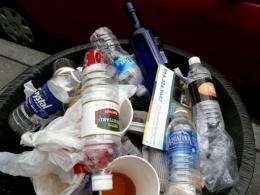In North Atlantic, researchers find a sea of garbage

The North Atlantic Ocean is looking more like a rubbish bin, with plastic and polystyrene flotsom spreading far and wide, according to four French explorers just back from eight months at sea.
Once out of the Brittany port of Trinite-sur-Mer in October, they typically spotted at least four to five pieces of trash a day -- only to sail into a veritable floating dump in April in the Sargasso Sea around Bermuda.
"In 15 minutes we saw more garbage than at any time during our journey," recalled naval engineer Yann Geffriaud, 27, speaking from his yacht a few hours after the crew's return on Saturday.
"It was truly a shock, when in the middle of nowhere we came across 10 to 20 pieces of garbage every five minutes."
The Sargasso Sea, where currents between Florida and Bermuda converge, is named for a brown seaweed -- sargassum -- that proliferates on its surface, entrapping any floating trash.
"Ninety-five percent of the stuff is plastics, from toothpaste tubes to aerosol containers and water bottles," said Geffriaud, founder of Watch the Waste, a group that asks mariners to monitor trash on the high seas.
"Frankly speaking, we did not see a compact area of plastic, but a scattering," added Geffriaud, whose team included an anthropologist taking stock of the seabound residue of modern civilisation.
The findings echoed those of US seafarer and researcher Charles Moore who two years ago sailed the Great Pacific Garbage Patch -- some 100 million tonnes of trash sprawled between Hawaii and Japan.
Moore was part of the Atlantic project in spirit, providing a dinghy for its bluewater sloop. His Algalita group also co-sponsored the effort, along with France's independent rubbish monitoring centre CNIID and two NGOs.
Last February, the US-based Sea Education Association revealed the existence of another virtual island of plastic in the North Atlantic, spread over a surface area as big as France.
Outside the Sargasso Sea, Yann said, the French expedition regularly came across garbage, much of which had been swept from dry land into the ocean by streams and rainfall.
"But we saw five times more on the way back, between Bermuda and the Azores, than on the way out along a more southerly track from Cape Verde to Tobago," he said.
Sailing closer to the Gulf Stream that sweeps from the Gulf of Mexico to northern Europe, its 10.5-metre yacht came across swirling waters along the edge of the main current that favoured an intermingling of rubbish.
"Given that we can never clean up the sea, the most simple thing to do is to raise public awareness," Yann and his team said.
(c) 2010 AFP
















